 From left: Thayer, Keller and Patiashivili pose with the Formula SAE car.
From left: Thayer, Keller and Patiashivili pose with the Formula SAE car.
As multi-year members of the Formula SAE student group, mechanical
engineering and mechanics majors Jon Keller and Juba Patiashivili and
electrical engineering major Will Thayer have had plenty of experience
designing and building race cars. They are continuously thinking of ways to
optimize their designs and make the fastest car. When deciding on what to
tackle for their senior design project, the choice was clear.
The team designed a dynamometer specifically for small engines.
Dynamometers, or “dynos,” record the torque and rotation speed of an
engine, providing a detailed measurement of the engine’s performance. The
team’s goal is to create a small, inexpensive dyno that can be used by the
hobbyist and student communities, who must currently rent the devices at
great cost.
To achieve their goal, the team used a hub-mounted dyno, which is
specifically designed to be easily mounted on the wheel hub of a small
engine. This type of dyno is compact, portable, and allows for quick and
easy testing of small engines without the need for expensive equipment or a
dedicated testing facility. The team's hope is that their hub-mounted dyno
will help make engine testing more accessible and affordable.
More than just a senior design project, the dynamometer is a critical tool in helping Formula SAE fine-tune the engine that will be used in their car, which will compete in time trials against more than 100 other collegiate teams in a nationwide SAE competition in Michigan on May 16. By remapping the engine based on data collected
from the dyno, they hope to increase their chances of success at the
upcoming competition.
Unlike most teams, which work through the spring term to complete their
project, the SAE team are rushing to complete theirs as early as possible
so that they can use the dyno in designing the group’s next car. "We are
currently in the final stages of completing the dyno, and we anticipate
that it will be finished within the next two weeks,” Keller said. “This
will give us enough time to thoroughly test and optimize our engine,
ensuring that we have the best possible performance for the upcoming
competition."
The team said that the experience in manufacturing and design from co-op as
well as involvement with the SAE team was incredibly useful to bring this
project to life. “One of the most important things we learned is the power
of teamwork,” Patiashivili said. “We have realized that when we work
collaboratively, we can achieve success that we may not have been able to
on our own.”
To learn more about their project and watch their pitch video, visit
their team page.